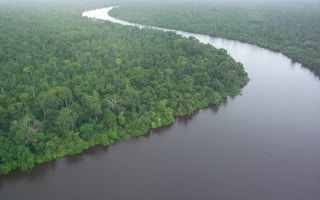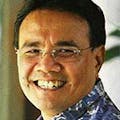This week I accompanied a group of reporters to visit Tanjung Leban village in Bengkalis district, Riau. There, some local farmers are trying new crops after losing their oil palm plots to fires and the Center for International Forestry Research (CIFOR) is conducting research.
I remember in 2015 when fires were raging in Indonesia, especially in Kalimantan. This was the top story for months on end. In the following dry season, in 2016, there was almost no news on peat fires and haze pollution. Was this because the government and communities had succeeded in preventing fires? Or was it simply because 2016 was a wetter year and there were fewer fires?
As a scientist, peatlands matter to me because of their unique biological and conservation values. The scientific community is now documenting how immensely valuable peatlands are in storing carbon – and therefore for mitigating climate change.
For generations, peatlands have been the pulse and heartbeat of communities and their livelihoods. Sago, fish, latex and other goods generate income for these communities. The ecosystem services of peatlands have proven to support socio-cultural values, identities, and human well-being in a sustainable way over a long period of time.
Peat is a type of organic soil made up of partially decomposed vegetation debris formed over thousands of years in waterlogged conditions. Peatlands need waterlogging to function, and will retain peat as long as there is water.
Peatlands exist in at least 180 countries, cover 3 to 5 percent of the total global land surface and make up about half of the world’s wetlands. Indonesia has a vast peatland ecosystem area – indeed the world’s largest peatland area – with many vital functions. These landscapes are a source of life for plants, animals and millions of people.
Yet these wetland ecosystems turn out to be so fragile when they are converted by deforestation and draining at a massive scale. Disaster after disaster, including floods, droughts, fires and haze pollution over the last 20 years have pounded the ecosystem.
Indonesia hit rock bottom in 2015. Millions of hectares of peatlands burned, millions of tons of greenhouse and toxic gases were released, communities suffered severe health problems and billions of dollars were lost as national and regional economic activities were disrupted.
The daily news on this disaster opened the world’s eyes to the impact of mismanaging peatlands and allowing uncontrolled forest fires.
Solutions are complex and they need to address a multitude of dimensions. They need to address people’s livelihoods. They need to address how the climate is disrupted by emissions from peatlands. And they must take into account the need for conservation of biodiversity.
Complex solutions like these, however, also need to be translated into simple and tangible actions, so that everyone can understand, move forward and contribute to the improvement of degraded peatlands.
“
Indonesia has an important leadership role to play by showing other countries around the world how to improve the lives of communities and conserve threatened species that are dependent on peatlands.
Local communities and local farmers need access to markets, they need access to capital, and they need possibilities to develop their smallholder businesses in sustainable ways. And all of that needs to be included in our data, our science and our research.
Nationally Determined Contributions to halt climate change should be regularly updated. Information generated by science will drive policy change, and innovative green financing schemes need to be promoted.
It’s really encouraging to see so many political initiatives to restore carbon. Here in Indonesia, and in other parts of the world, it’s really important to put ecosystem functions back into place in many of these peatlands.
Indonesia can lead
By conserving and using peatlands wisely, Indonesia can remain a giant for long time to come among agro-based industrial countries. The real challenge is to make peatland resources a blessing rather than a curse. Former U.S. Vice President Al Gore called peatlands a “renewable resource”. We need to be able to leave this legacy for our children and grandchildren.
A stronger legal framework is needed for communities and environment. The government has the ‘sword’ to protect and punish any practice that undermines the law.
Being one of the countries that hosts vast tropical peatlands, Indonesia is well positioned to lead others that have not gone through the various disasters we have faced. The lessons learned by Indonesia are valuable to peatland-rich countries like the Republic of Congo, the Democratic Republic of Congo, and Peru.
I welcome the Global Landscapes Forum: Peatlands Matter conference – led by the Center for International Forestry Research, the World Bank and the United Nations Environment Programme – and encourage its participants to discuss the need to sustainably manage and preserve peatlands globally, and the lessons we can share from Indonesia.
Indonesia has an important leadership role to play by showing other countries around the world how to improve the lives of communities and conserve threatened species that are dependent on peatlands.
Daniel Murdiyarso is senior scientist at the Center for International Forestry Research (CIFOR). This article is republished from Thomson Reuters Foundation .











